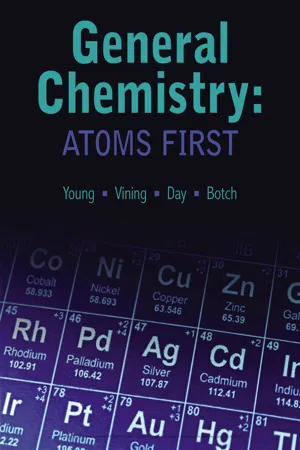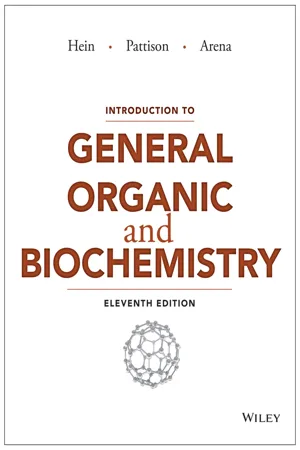Chemistry
Balancing Nuclear Equations
Balancing nuclear equations involves ensuring that the total number of protons and neutrons on both sides of the equation are equal, thus maintaining the conservation of mass and charge. This process is essential for accurately representing nuclear reactions, including radioactive decay and nuclear fission or fusion. It requires adjusting the coefficients of the reactants and products to achieve equilibrium.
Written by Perlego with AI-assistance
Related key terms
1 of 5
9 Key excerpts on "Balancing Nuclear Equations"
- eBook - PDF
- Young, William Vining, Roberta Day, Beatrice Botch(Authors)
- 2017(Publication Date)
- Cengage Learning EMEA(Publisher)
When writing an equation to represent a decay process or any other nuclear process, the reaction must be balanced. Just as a balanced chemical equation must have the same number of atoms of each element on each side of the reaction arrow, a balanced nuclear reaction must have the same number of nuclear particles on each side of the reaction arrow. We balance nuclear equations by balancing both mass and charge; the sum of the mass numbers of the reactants (the sum of the protons and neutrons in the nuclei) is equal to the sum of the mass numbers of the products, and charge balance is obtained by balanc-ing the atomic numbers of the reactants and products. Copyright 2018 Cengage Learning. All Rights Reserved. May not be copied, scanned, or duplicated, in whole or in part. WCN 02-300 Unit 25 Nuclear Chemistry 807 For example, consider the alpha decay of uranium-238. 238 92 U S 234 90 Th 1 4 2 a Number of protons 92 90 2 Number of neutrons 146 144 2 Total mass 238 234 4 The mass number of U-238 is equal to the sum of the mass numbers of thorium-234 (Th-234) and an alpha particle. In addition, charge is balanced because the number of protons is balanced (92 5 90 1 2) . Both mass and charge are balanced in this reaction. When balancing reactions involving charged species such as electrons, beta particles, positrons, and protons, the atomic number assigned to the particle changes the proton count for the reaction. Consider this electron capture process: 83 37 Rb 1 0 2 1 e S 83 36 Kr Number of protons 37 2 1 36 Number of neutrons 46 0 47 Total mass 83 0 83 An electron really does not have a “ 2 1 ” number of protons; however, assigning electrons and beta particles an atomic number of 2 1 maintains charge balance in the reaction. In the preceding reaction, there is a total charge of 37 1 ( 2 1) 5 36 in the reactants, which balances the charge in the product nuclide. - eBook - PDF
- John A. Olmsted, Gregory M. Williams, Robert C. Burk(Authors)
- 2020(Publication Date)
- Wiley(Publisher)
The notion of conservation of mass is valid within experimental error for all chemical transformations, as Example 21.3 illustrates. For nuclear processes, however, the amounts of energy produced or consumed are large enough to generate measurable mass changes. In nuclear decay, some mass is always converted into energy. We can use Equation 21.3, the mass of the decaying nucleus, and the masses of its products to calculate how much energy is released. This reasoning is easily applied to the decay of a free neutron. The masses of the three participants are given in Table 21.1: Neutron: 1.008 665 g /mol Proton: 1.007 276 g /mol Electron: 0.000 5486 g /mol Δm = 1.007 276 + 0.000 5486 − 1.008 665 = − 0.000 840 g /mol ΔE = (− 0.000 840 g /mol ) (8.988 × 10 10 k J/g ) = − 7.55 × 10 10 k J/mol To summarize, the equation for a nuclear reaction is balanced when the total charge and total mass number of the products equal the total charge and total mass number of the reac- tants. This conservation requirement is one reason why the symbol for any nuclide includes its charge number (Z ) as a subscript and its mass number (A) as a superscript. These features provide a convenient way to keep track of charge and mass balances. Notice that in the equa- tion for neutron decay, the sum of the subscripts for reactants equals the sum of the subscripts for products. Likewise, the sum of the superscripts for reactants equals the sum of the super- scripts for products. We demonstrate how to balance equations for other reactions as they are introduced. 21. 2 Nuclear Decay 1037 Decay Processes There are five fundamental types of nuclear decay process, as listed in Table 21.3. Figure 21.6 diagrams how nuclear decays affect N and Z. As the figure suggests, the decay process of any particular unstable nuclide depends on the reason for its instability. Many nuclides that are too massive to be stable lose mass by emitting energetic helium nuclei, reducing A by 4 units and Z by 2 units. - eBook - PDF
- Morris Hein, Susan Arena, Cary Willard(Authors)
- 2021(Publication Date)
- Wiley(Publisher)
To represent the quantitative relationships of a reaction, the chemical equation must be bal- anced. A balanced equation contains the same number of each kind of atom on each side of the equation. The balanced equation therefore obeys the law of conservation of mass. Every chemistry student must learn to balance equations. Many equations are balanced by trial and error, but care and attention to detail are still required. The way to balance an equation is to adjust the number of atoms of each element so that they are the same on each side of the equation, but a correct formula is never changed in order to balance an equation (see note). The general procedure for balancing equations follows. Study this procedure care- fully and refer to it when you work examples. CHECK YOUR UNDERSTANDING 8.1 Law of Conservation of Mass Note Correct formulas are not changed to balance an equation. EX AMPLE 8.1 Classify each formula in the chemical reactions below as a reactant or a product. a. MnO 2 + 4 HCl ⟶ MnCl 2 + Cl 2 + 2 H 2 O b. Na 2 SO 3 + H 2 SO 4 ⟶ Na 2 SO 4 + SO 2 + H 2 O Solution a. Reactants: MnO 2 and HCl Products: MnCl 2 , Cl 2 , and H 2 O b. Reactants: Na 2 SO 3 , and H 2 SO 4 Products: Na 2 SO 4 , SO 2 , and H 2 O PR AC TICE 8.1 How is a substance in a chemical equation identified as a solid, a gas, or in a water solution? Try a similar problem in PROBLEM SOLVING VIDEO Analyzing Chemical Equations 158 CHAPTER 8 Chemical Equations Problem-Solving Strategy For Writing and Balancing a Chemical Equation 1. Identify the reaction. Write a description or word equation for the reaction. For example, let’s consider mercury(II) oxide decomposing into mercury and oxygen. mercury (II) oxide Δ ⟶ mercury + oxygen 2. Write the unbalanced (skeleton) equation. Make sure that the formula for each substance is correct and that reactants are written to the left and products to the right of the arrow. - eBook - ePub
Green Chemistry and Engineering
A Pathway to Sustainability
- Anne E. Marteel-Parrish, Martin A. Abraham(Authors)
- 2013(Publication Date)
- Wiley-AIChE(Publisher)
5
CHEMICAL REACTIONS
5.1 DEFINITION OF CHEMICAL REACTIONS AND BALANCING OF CHEMICAL EQUATIONS
The concept of molecules and compounds was introduced in Chapter 4. Chemists and chemical engineers manipulate compounds to form new materials that achieve a specific goal or purpose. It is of crucial importance that compounds be mixed in the proper ratios so that the desired reaction can be achieved. The relationship between the compound and its atoms is displayed through the molecular formula, and the chemist uses this information to develop a balanced chemical equation that can properly describe the breaking and forming of bonds in chemical reactions.As mentioned in Chapter 4, a chemical reaction is “a process in which substances (reactants) change into other substances (products) by rearrangement, combination, or separation of atoms.” A chemical reaction is represented by a chemical equation with two sides: one for the reactants and one for the products.The arrow means “forms,” “yields,” “changes to,” or “is/are converted into.”The law of conservation of matter, “matter is neither destroyed nor created,” applies to all atoms in a chemical reaction. As a result, a balanced chemical reaction requires that there must be an equivalent number of atoms of each type on both sides of the equation. Consider the reaction between hydrogen and oxygen to form water, as shown in Equation 5.1 .(5.1 )In Equation 5.1 , we have placed a letter in front of each molecule to represent the stoichiometric coefficient, a multiplying number assigned to the species in a chemical equation in order to balance the equation. Now the challenge is to determine what number each letter in Equation 5.1 represents.Let’s suppose we were producing one molecule of water. In this case, there would be one oxygen atom on the right-hand side of the equation, and to have a balanced chemical equation would require that we have one oxygen atom on the left side. But diatomic oxygen is shown on the left side, and it is not possible to have fractional numbers of molecules. So the smallest number of oxygen molecules on the left side would be one. Based on this analysis, let’s tentatively state that m - eBook - PDF
- William R. Robinson, Edward J. Neth, Paul Flowers, Klaus Theopold, Richard Langley(Authors)
- 2016(Publication Date)
- Openstax(Publisher)
Example 20.4 Balancing Equations for Nuclear Reactions The reaction of an α particle with magnesium-25 ( 12 25 Mg) produces a proton and a nuclide of another element. Identify the new nuclide produced. Solution The nuclear reaction can be written as: 12 25 Mg + 2 4 He ⟶ 1 1 H + Z A X where A is the mass number and Z is the atomic number of the new nuclide, X. Because the sum of the mass numbers of the reactants must equal the sum of the mass numbers of the products: 25 + 4 = A + 1, or A = 28 Similarly, the charges must balance, so: 12 + 2 = Z + 1, and Z = 13 Check the periodic table: The element with nuclear charge = +13 is aluminum. Thus, the product is 13 28 Al. Check Your Learning The nuclide 53 125 I combines with an electron and produces a new nucleus and no other massive particles. What is the equation for this reaction? Answer: 53 125 I + −1 0 e ⟶ 52 125 Te Following are the equations of several nuclear reactions that have important roles in the history of nuclear chemistry: • The first naturally occurring unstable element that was isolated, polonium, was discovered by the Polish scientist Marie Curie and her husband Pierre in 1898. It decays, emitting α particles: 84 212 Po ⟶ 82 208 Pb + 2 4 He • The first nuclide to be prepared by artificial means was an isotope of oxygen, 17 O. - eBook - PDF
Chemistry
An Atoms First Approach
- Steven Zumdahl, Susan Zumdahl, Donald J. DeCoste, , Steven Zumdahl, Steven Zumdahl, Susan Zumdahl, Donald J. DeCoste(Authors)
- 2020(Publication Date)
- Cengage Learning EMEA(Publisher)
All Rights Reserved. May not be copied, scanned, or duplicated, in whole or in part. Due to electronic rights, some third party content may be suppressed from the eBook and/or eChapter(s). Editorial review has deemed that any suppressed content does not materially affect the overall learning experience. Cengage Learning reserves the right to remove additional content at any time if subsequent rights restrictions require it. Nuclear Equations I Write balanced equations for each of the following processes. a. 11 6 C produces a positron. b. 214 83 Bi produces a b particle. c. 237 93 Np produces an a particle. SOLUTION a. We must find the product nuclide represented by A Z X in the following equation: 11 6 C ¡ 0 1 e 1 A Z X h Positron We can find the identity of A Z X by recognizing that the total of the Z and A values must be the same on both sides of the equation. Thus for X, Z must be 6 2 1 5 5 and A must be 11 2 0 5 11. Therefore, A Z X is 11 5 B. (The fact that Z is 5 tells us that the nuclide is boron.) Thus the balanced equation is 11 6 C ¡ 0 1 e 1 11 5 B b. Knowing that a b particle is represented by 21 0 e and that Z and A are conserved, we can write 214 83 Bi ¡ 0 21 e 1 214 84 X so A Z X must be 214 84 Po. c. Since an a particle is represented by 4 2 He, the balanced equation must be 237 93 Np ¡ 4 2 He 1 233 91 Pa Nuclear Equations II In each of the following nuclear reactions, supply the missing particle. a. 195 79 Au 1 ? n 195 78 Pt b. 38 19 K n 38 18 Ar 1 ? SOLUTION a. Since A does not change and Z decreases by 1, the missing particle must be an electron: 195 79 Au 1 0 21 e ¡ 195 78 Pt This is an example of electron capture. b. To conserve Z and A, the missing particle must be a positron: 38 19 K ¡ 38 18 Ar 1 0 1 e Thus potassium-38 decays by positron production. - eBook - PDF
Chemistry
The Molecular Nature of Matter
- James E. Brady, Neil D. Jespersen, Alison Hyslop(Authors)
- 2014(Publication Date)
- Wiley(Publisher)
We have one reactant, the Cs that decays to give three particles: two known products, a beta particle and a neutron, and an unknown particle that must balance the equation. Therefore, we will use the requirements for a balanced nuclear equation as a tool to figure out any other data needed to complete the equation. Solution: The incomplete nuclear equation is Atomic symbol goes here. Atomic number goes here. Mass number goes here. + g + e 0 0 -1 0 Cs 55 137 ■ Ions of cesium, which is in Group 1A with sodium, travel in the body to many of the same sites where sodium ions go. 20.3 | Radioactivity 971 We need to determine Z and A and then we’ll use X to identify the symbol for the element. For the superscripts we see that 137 will be the superscript, A, for X since all other super- scripts are zero. For the subscripts we see that X must be 56 (since 55 = -1 + 56). We can now use 56 to identify the element as barium, and use its symbol Ba. Now we fill in the last term as 137 56 Ba the balanced equation is: 137 55 Cs h 0 -1 e + 0 0 g + 137 56 Ba Is the Answer Reasonable? Besides double-checking that element 56 is barium, the answer satisfies the requirements of a nuclear equation—namely, the sums of the mass numbers, 137, are the same on both sides, as are the sums of the atomic numbers. Marie Curie earned one of her two Nobel Prizes for isolating the element radium, which soon became widely used to treat cancer. Radium-226, 226 Ra, emits a gamma photon plus an alpha particle to give radon-222. Write a balanced nuclear equation for its decay and identify the particle that’s emitted. (Hint: Be sure to balance atomic numbers and mass numbers.) Write the balanced nuclear equation for the decay of iodine-131, a beta emitter. - Morris Hein, Scott Pattison, Susan Arena, Leo R. Best(Authors)
- 2014(Publication Date)
- Wiley(Publisher)
Interpretation of a balanced equation gives us the following information: 1. What the reactants are and what the products are 2. The formulas of the reactants and products 3. The number of molecules or formula units of reactants and products in the reaction 4. The number of atoms of each element involved in the reaction 5. The number of moles of each substance Consider the reaction that occurs when propane gas (C 3 H 8 ) is burned in air; the products are carbon dioxide (CO 2 ) and water (H 2 O). The balanced equation and its interpretation are as follows: We generally use moles in equations because molecules are so small. � � Propane C 3 H 8 (g) 1 molecule 3 atoms C 8 atoms H 1 mol 44.09 g Carbon dioxide 3 CO 2 (g) 3 molecules 3 atoms C 6 atoms O 3 mol 3(44.01 g) = (132.0 g) Water 4 H 2 O(g) 4 molecules 8 atoms H 4 atoms O 4 mol 4(18.02 g) = (72.08 g) Oxygen 5 O 2 (g) 5 molecules 10 atoms O 5 mol 5(32.00 g) = (160.0 g) P R A C T I C E 8 . 3 Write a balanced formula equation for: magnesium hydroxide + phosphoric acid ¡ magnesium phosphate + water 150 CHAPTER 8 • Chemical Equations The quantities involved in chemical reactions are important when working in industry or the laboratory. We will study the relationship among quantities of reactants and products in the next chapter. 8.3 TYPES OF CHEMICAL EQUATIONS Give examples of a combination reaction, decomposition reaction, single- displacement reaction, and double-displacement reaction. Chemical equations represent chemical changes or reactions. Reactions are classified into types to assist in writing equations and in predicting other reactions. Many chemical reac- tions fit one or another of the four principal reaction types that we discuss in the following paragraphs. Reactions are also classified as oxidation–reduction. Special methods are used to balance complex oxidation–reduction equations. (See Chapter 17.) Combination Reaction In a combination reaction, two reactants combine to give one product.- eBook - PDF
Chemistry for Today
General, Organic, and Biochemistry
- Spencer Seager, Michael Slabaugh, Maren Hansen, , Spencer Seager, Spencer Seager, Michael Slabaugh, Maren Hansen(Authors)
- 2021(Publication Date)
- Cengage Learning EMEA(Publisher)
Radioactivity and Nuclear Processes 309 Example 10.3 Writing Balanced Nuclear Equations Write a balanced nuclear equation for the decay of each of the following. The mode of decay is indicated in parentheses. a. 59 26 Fe (beta emission), used in diagnosing anemia, bone marrow function b. 122 53 I (positron emission) c. 55 26 Fe (electron capture) d. 212 84 Po (alpha emission) Solution In each case, the atomic number of the daughter is obtained by balancing atomic numbers in the equation. The symbol for the daughter is obtained by matching atomic numbers to symbols in the periodic table. a. 59 26 Fe S 0 21 b 1 59 27 Co b. 122 53 I S 0 1 b 1 122 52 Te c. 55 26 Fe 1 0 21 e S 55 25 Mn d. 212 84 Po S 4 2 a 1 208 82 Pb ✔ LEARNING CHECK 10.5 Write a balanced nuclear equation for the decay of each of the following. The mode of decay is indicated in parentheses. a. 50 25 Mn (positron emission) b. 54 25 Mn (electron capture) c. 56 25 Mn (beta emission) d. 224 88 Ra (alpha emission) 10.3 Isotope Half-Life Learning Objective 3 Solve problems using the half-life concept. Some radioactive isotopes are more stable than others. The more stable isotopes undergo radioactive decay more slowly than the less stable isotopes. The half-life of an isotope is used to indicate stability, and it is equal to the time required for one-half (50%) of the at- oms of a sample of the isotope to decay. Table 10.2 contains examples showing the wide range of half-lives that have been determined. half-life The time required for one- half the unstable nuclei in a sample to undergo radioactive decay.
Index pages curate the most relevant extracts from our library of academic textbooks. They’ve been created using an in-house natural language model (NLM), each adding context and meaning to key research topics.








